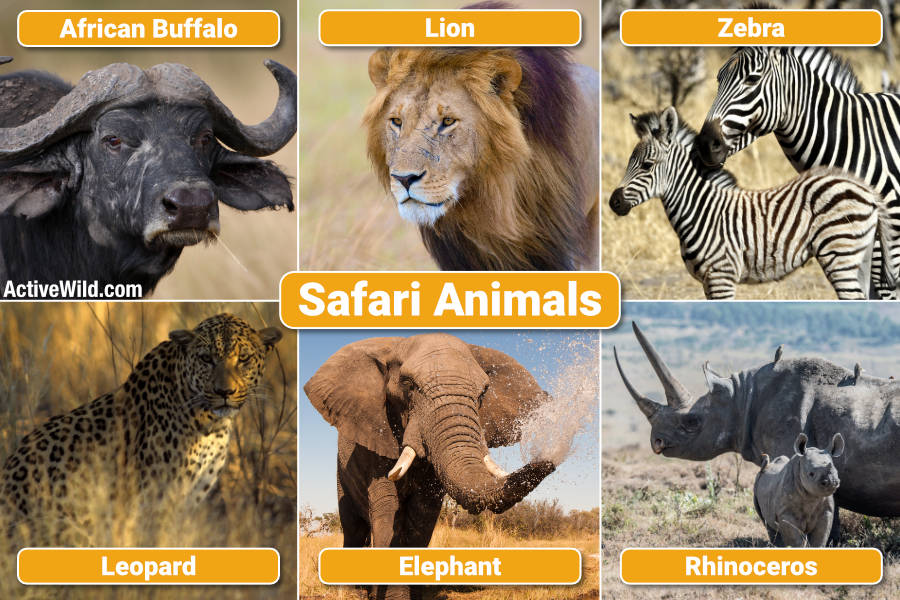Safari animals include the iconic “Big Five” consisting of the lion, African elephant, leopard, rhinoceros and African buffalo, together with other African species such as antelopes, baboons, zebras, hyenas, crocodiles, ostriches and vultures.
On this page is a list of safari animals, with pictures and interesting facts on each species. Whether you’re planning a safari trip yourself, or are simply interested in the incredible variety of life in Africa’s savannas, this page will help you find out more about some of the world’s most incredible animals.
Introduction
Embarking on a safari is like stepping into a living, breathing nature documentary. From the sprawling savannas of the Serengeti to the dense forests of the Congo, these trips offer an unparalleled glimpse into the lives of some of the world’s most famous animals.
For those not planning on visiting Africa themselves, this page offers the next best thing: here you’ll find a list of safari animals with pictures and interesting facts on each species.
On this page you’ll find information not only on the big five, but also on many other fascinating African species…
Safari Animals Index
Scroll down to browse the animals, or use the links below to view individual species.
Aardvark
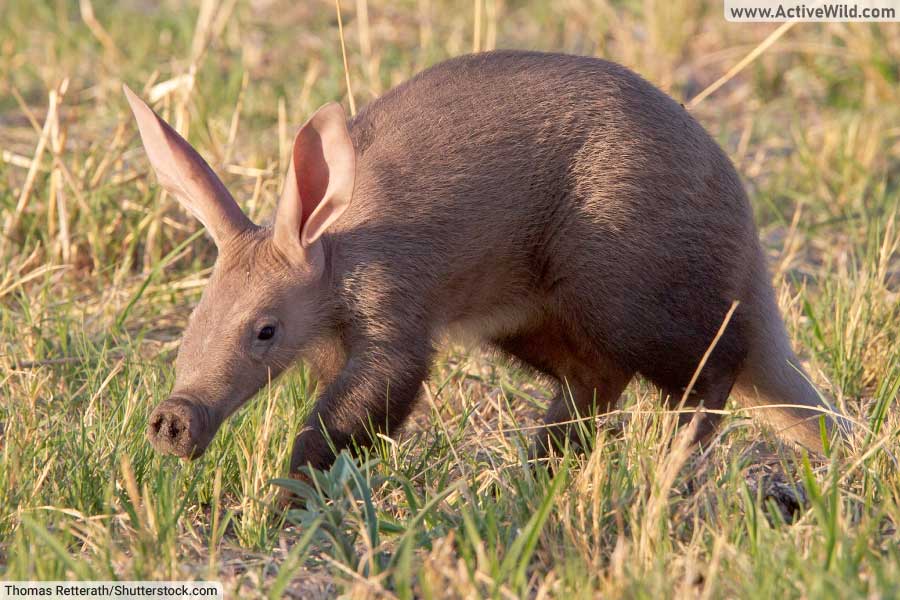

- Scientific Name: Orycteropus afer
- Class: Mammalia
- Order: Tubulidentata
- Family: Orycteropodidae
- Where Found: Sub-Saharan Africa
- Conservation Status: Least Concern
The aardvark is a nocturnal mammal native to Africa, known for its unique tubular snout and powerful digging abilities. It primarily feeds on ants and termites, using its long, sticky tongue to capture them from deep within their nests.
Aardvarks play a crucial role in their ecosystem by controlling insect populations and providing abandoned burrows as shelters for other animals.
You can find out more about this animal on this page: Aardvark Facts
Aardwolf
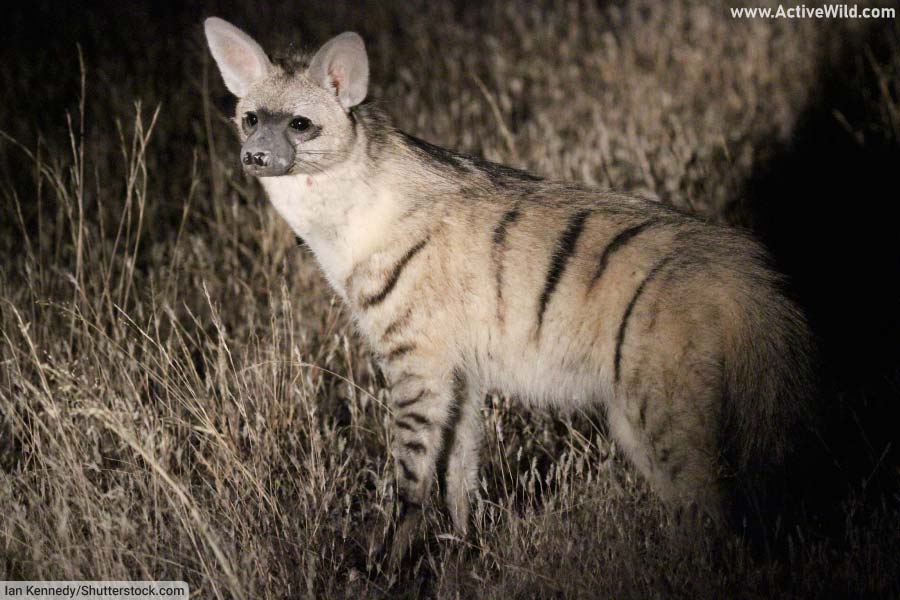

- Scientific Name: Proteles cristata
- Class: Mammalia
- Order: Carnivora
- Family: Hyaenidae
- Where Found: Eastern and Southern Africa
- Conservation Status: Least Concern
The aardwolf is a nocturnal mammal native to East and Southern Africa. It is a member of the hyena family (Hyaenidae), but unlike its carnivorous relatives, feeds primarily on termites, consuming up to 200,000 of the insects in a single night.
The aardwolf is equipped with a sticky tongue to lap its insect prey up.
You can find out more about this animal on this page: Aardwolf Facts
African Buffalo
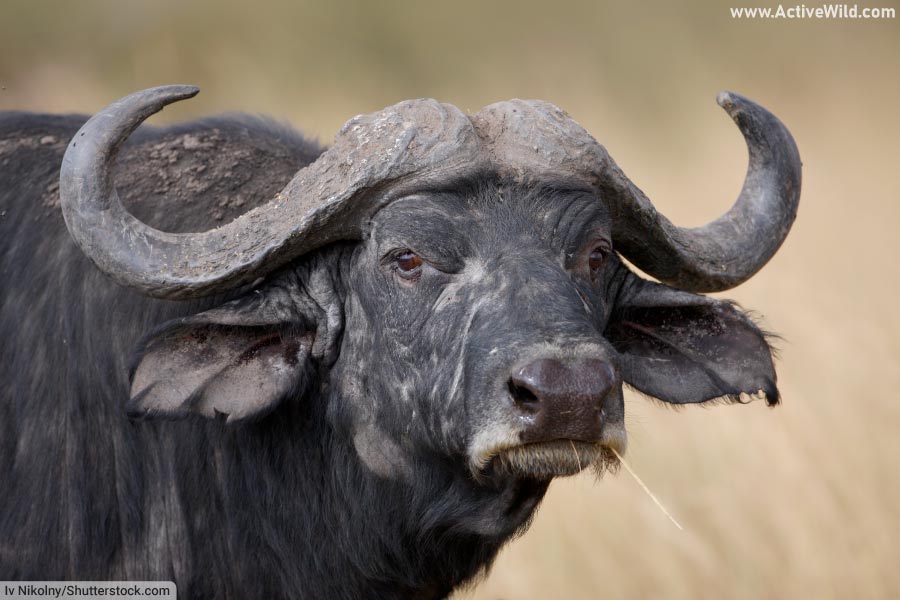

- Scientific Name: Syncerus caffer
- Class: Mammalia
- Order: Artiodactyla
- Family: Bovidae
- Where Found: Sub-Saharan Africa
- Conservation Status: Near Threatened
The African buffalo, also known as the Cape buffalo, is a large herbivore found throughout sub-Saharan Africa. It is one of the “Big Five”, and one of the most iconic African animals.
Known for its unpredictable nature and strong herd instincts, the African buffalo is one of the most dangerous animals in Africa, capable of defending itself against predators like lions.
African buffaloes are highly social animals, living in large herds that can number in the hundreds, providing mutual protection and enhancing their survival in the wild.
You can find out more about this animal on this page: African Buffalo Facts
African Civet


- Scientific Name: Civettictis civetta
- Class: Mammalia
- Order: Carnivora
- Family: Viverridae
- Where Found: Sub-Saharan Africa
- Conservation Status: Least Concern
The African civet is a nocturnal mammal found in sub-Saharan Africa, distinguished by its striking black and white markings and a unique musk used in perfume production.
An omnivore, the African civet has a varied diet, which includes fruits, insects, small mammals, and birds.
The species’ solitary and secretive lifestyle, coupled with its ability to climb trees, means that it’s rarely seen.
You can find out more about the different types of mammals on this page: Types Of Mammals
African Elephant
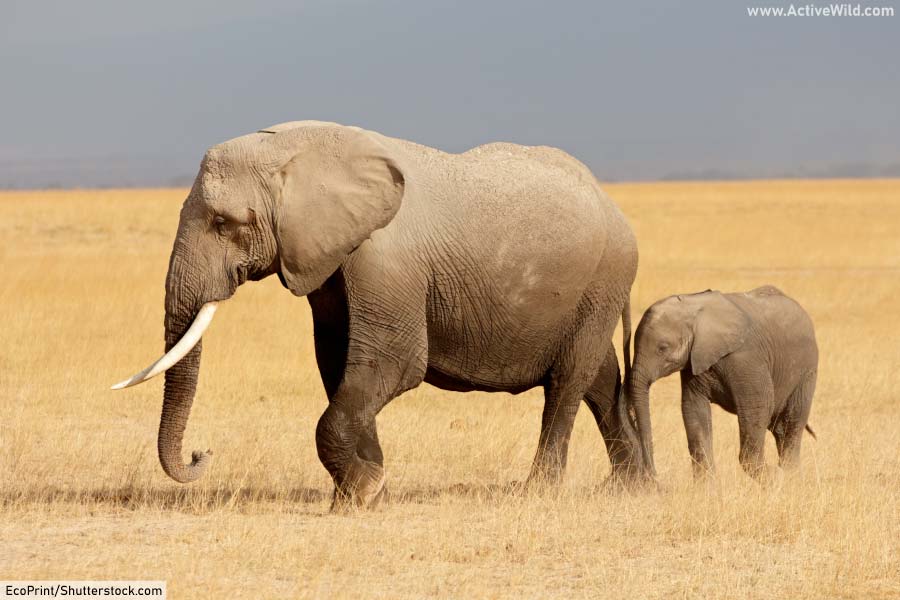

- Scientific Name: Loxodonta africana
- Class: Mammalia
- Order: Proboscidea
- Family: Elephantidae
- Where Found: Sub-Saharan Africa
- Conservation Status: Endangered
The African elephant is the largest land animal on Earth, known for its impressive tusks, large ears, and strong social bonds. (Both male and female African elephants have tusks, unlike the Asian elephant, in which only the male has tusks.)
Despite their size and strength, African elephants face significant threats from poaching and habitat loss, making conservation efforts vital for their survival.
Found across various habitats in sub-Saharan Africa, these intelligent giants play a crucial role in their ecosystems by shaping the landscape and dispersing seeds.
You can find out more about this animal on this page: African Elephant Facts
African Wild Dog
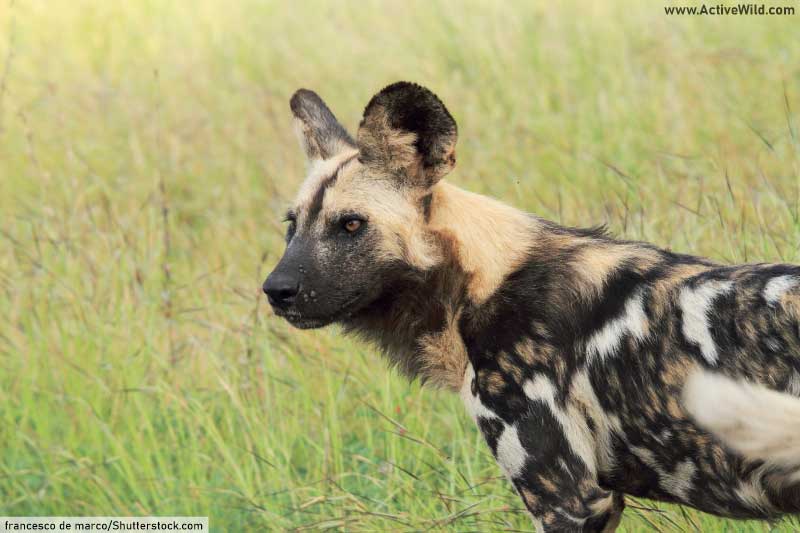

- Scientific Name: Lycaon pictus
- Class: Mammalia
- Order: Carnivora
- Family: Canidae
- Where Found: Sub-Saharan Africa
- Conservation Status: Endangered
The African wild dog, also known as the painted dog, is a highly social and efficient pack hunter found in the savannas and lightly wooded areas of sub-Saharan Africa.
Characterized by its mottled coat of black, white, and tan patches, each individual has a unique pattern that aids in identification.
These endangered members of the dog family (Canidae) are known for their exceptional teamwork and communication during hunts, often achieving hunting success rates far higher than those of lions.
The African wild dog competes for resources with lions and spotted hyenas, and is often killed by the larger predators.
You can find out more about this animal on this page: African Wild Dog Facts
Antelope – Gemsbok
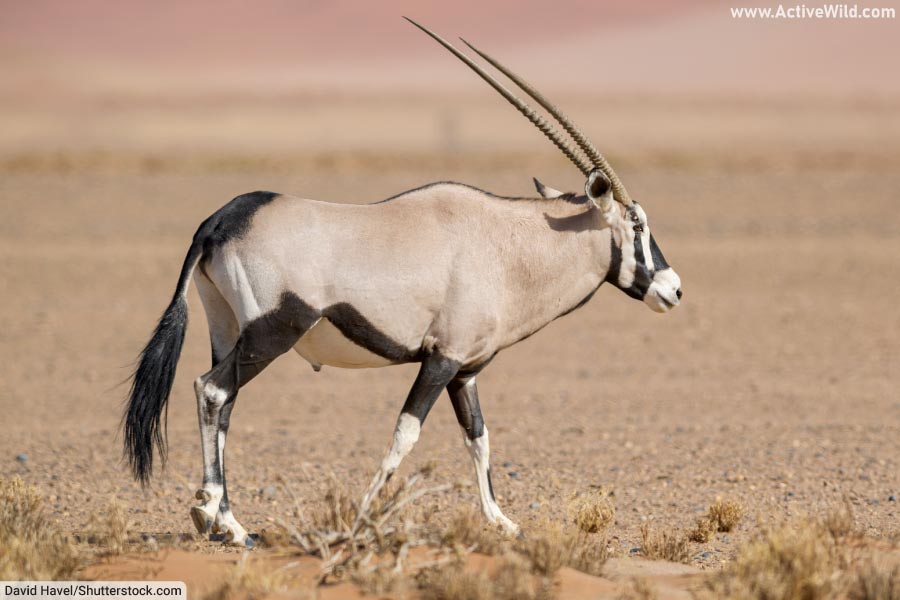

- Scientific Name: Oryx gazella
- Class: Mammalia
- Order: Artiodactyla
- Family: Bovidae
- Where Found: Southern Africa
- Conservation Status: Least Concern
The gemsbok, also known as the South African oryx, is a large antelope native to the arid regions of Southern Africa, renowned for its striking black-and-white facial markings and long, straight horns.
Adapted to desert life, gemsboks can survive without water for extended periods, obtaining moisture from the plants they consume. Their horns, which can reach up to 85 centimeters in length, are used for defense against predators and in territorial battles between males.
You can see more horned animals on this page: Animals With Horns
Antelope – Greater Kudu
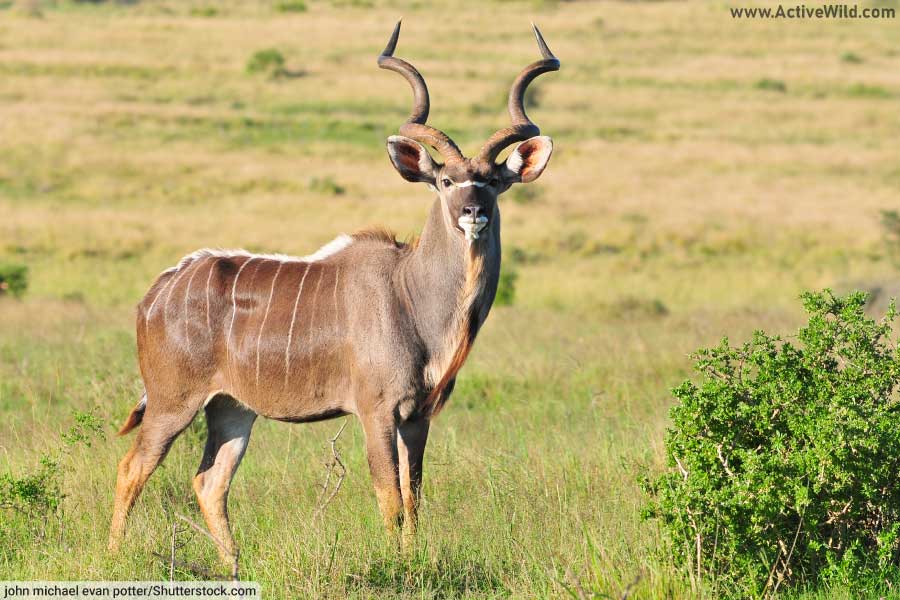

- Scientific Name: Tragelaphus strepsiceros
- Class: Mammalia
- Order: Artiodactyla
- Family: Bovidae
- Where Found: Eastern and Southern Africa
- Conservation Status: Least Concern
The greater kudu is a majestic antelope native to Eastern and Southern Africa, easily recognizable by its impressive spiraled horns that can grow up to 1.8 meters long in males.
With a striking coat featuring white vertical stripes and a distinctive hump over its shoulders, the greater kudu is well-adapted to blending into the woodland and savanna habitats it frequents.
These shy and elusive animals are primarily browsers, feeding on leaves, shoots, and fruits, and are known for their remarkable ability to leap over obstacles and escape predators.
The related lesser Kudu (Tragelaphus imberbis) is found in Eastern Africa, and is Near Threatened.
You can see more horned animals on this page: Animals With Horns
Antelope – Impala
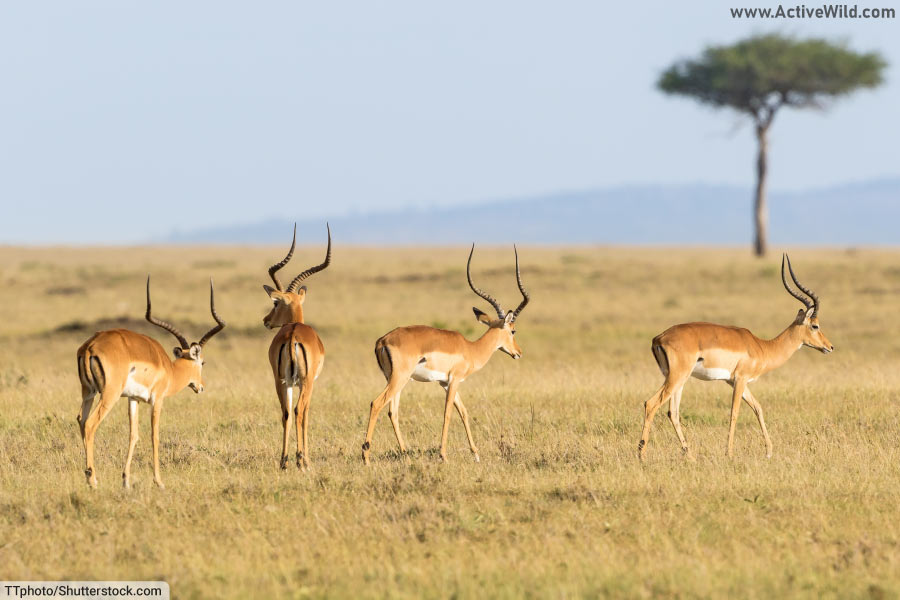

- Scientific Name: Aepyceros melampus
- Class: Mammalia
- Order: Artiodactyla
- Family: Bovidae
- Where Found: Eastern and Southern Africa
- Conservation Status: Least Concern
The impala is a graceful and agile antelope found in the savannas and woodlands of Eastern and Southern Africa.
Known for their remarkable jumping ability, impalas can leap up to 3 meters high and cover distances of up to 10 meters in a single bound, helping them evade predators.
Highly social animals, impalas live in large herds, which provide protection through numbers and enhance their chances of survival in the wild.
You can see other animals with horns on this page: Animals With Horns
Antelope – Nyala
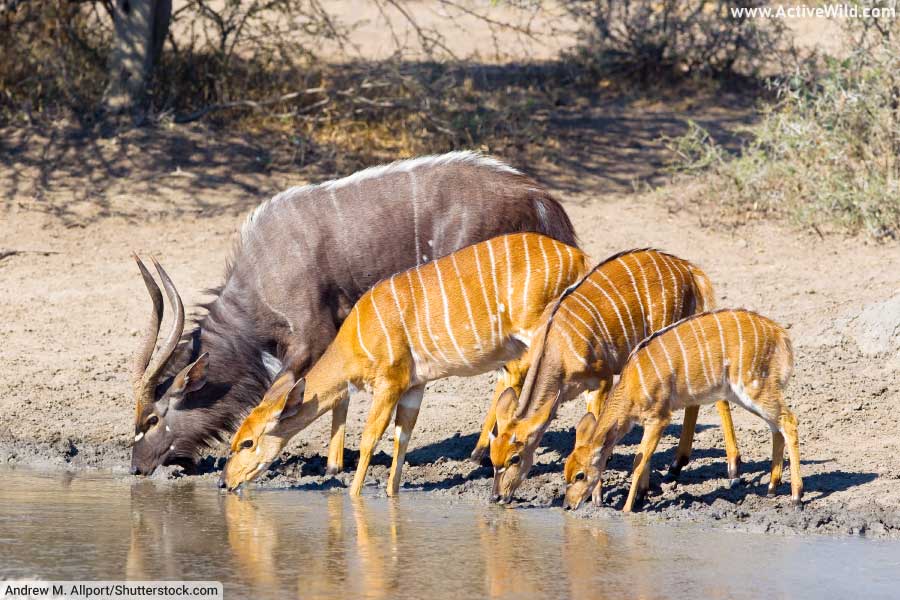

- Scientific Name: Tragelaphus angasii
- Class: Mammalia
- Order: Artiodactyla
- Family: Bovidae
- Where Found: Southeastern Africa
- Conservation Status: Least Concern
The nyala is a medium-sized antelope found in the dense woodlands and thickets of Southern Africa, distinguished by its shaggy coat and striking sexual dimorphism (the difference between males and females of the same species).
Males are larger with dark brown or slate-gray fur, prominent white stripes, and spiral horns, while females are smaller and a rich chestnut color without horns.
Nyalas are browsers, feeding on leaves, fruits, and twigs, and are known for their secretive nature and preference for staying close to water holes.
You can see other animals with horns on this page: Horned Animals
Antelope – Roan


- Scientific Name: Hippotragus equinus
- Class: Mammalia
- Order: Artiodactyla
- Family: Bovidae
- Where Found: Western, Central, and Southern Africa
- Conservation Status: Least Concern
The roan antelope is a large and robust antelope native to savannas and open woodlands of Western, Central, and Southern Africa. It lives in small herds led by a dominant male.
Named for its roan-colored coat, the roan antelope has striking black-and-white facial markings, long, backward-curving horns, and a distinctive mane along its neck.
The roan antelope is known for its aggressive behavior, especially during territorial disputes, with males often engaging in dramatic displays and battles for dominance. It will also aggressively protect its herd against predators, including humans.
You can see other animals with horns on this page: Animals With Horns
Antelope – Sable


- Scientific Name: Hippotragus niger
- Class: Mammalia
- Order: Artiodactyla
- Family: Bovidae
- Where Found: Eastern and Southern Africa
- Conservation Status: Least Concern
The sable antelope is a striking and robust antelope found in the woodlands and savannas of Eastern and Southern Africa. It is easily recognizable by its glossy black coat in males, chestnut brown in females, and its impressive, curved-back horns that can reach over a meter in length.
Known for their bravery, sable antelopes will fiercely defend themselves and their herd against predators, often forming protective circles with their horns facing outward.
You can see other animals with horns on this page: Animals With Horns
Antelope – Springbok


- Scientific Name: Antidorcas marsupialis
- Class: Mammalia
- Order: Artiodactyla
- Family: Bovidae
- Where Found: Southwestern Africa
- Conservation Status: Least Concern
The springbok is a small, graceful antelope native to the dry plains and open grasslands of Southern Africa. It is famous for its distinctive “pronking” behavior, where it leaps high into the air with stiff legs, which is believed to be a display of strength and alertness to predators.
Springboks are highly adaptable and can survive in arid environments by obtaining moisture from the succulent plants they eat, making them well-suited to their often harsh habitats.
You can find out more about this animal on this page: Springbok Facts
Antelope – Blue Wildebeest


- Scientific Name: Connochaetes taurinus
- Class: Mammalia
- Order: Artiodactyla
- Family: Bovidae
- Where Found: Eastern and Southern Africa
- Conservation Status: Least Concern
The blue wildebeest, also known as the common wildebeest, is a large antelope native to the open grasslands and savannas of Eastern and Southern Africa.
Distinguished by its robust build, sloping back, and distinctive bluish-gray coat, it has dark vertical stripes and a mane of black hair. The blue wildebeest is famed for its participation in the Great Migration, where vast herds undertake a perilous journey across the Serengeti and Maasai Mara in search of fresh grazing, providing one of the most dramatic wildlife spectacles on Earth.
The blue wildebeest is closely related to the black wildebeest. Both are also known as “gnus”.
You can find out more about this animal on this page: Wildebeest Migration Facts
Baboon – Chacma


- Scientific Name: Papio ursinus
- Class: Mammalia
- Order: Primates
- Family: Cercopithecidae
- Where Found: Southern Africa
- Conservation Status: Least Concern
The chacma baboon is a large and adaptable primate found in a variety of habitats across Southern Africa, from woodlands and savannas to mountainous regions. Known for its robust build, long, dog-like muzzle, and distinctive social structures, chacma baboons live in troops that can include dozens of individuals.
These omnivorous primates have a varied diet that includes fruits, seeds, insects, and small animals, and they are highly intelligent, displaying complex behaviors and communication within their troops.
You can find out more about baboons on this page: Baboon Facts
Baboon – Yellow


- Scientific Name: Papio cynocephalus
- Class: Mammalia
- Order: Primates
- Family: Cercopithecidae
- Where Found: Eastern Africa
- Conservation Status: Least Concern
The yellow baboon is a medium-sized primate native to the savannas and open woodlands of East Africa, characterized by its yellowish-brown fur and long, slender limbs.
Highly social animals, yellow baboons live in large, complex troops that exhibit a strict hierarchy, with both males and females having distinct social ranks. Their omnivorous diet includes fruits, seeds, insects, and small vertebrates, and they play a crucial role in their ecosystem by dispersing seeds and controlling insect populations.
You can find out more about baboons on this page: Baboon Facts
Hammer-Headed Bat
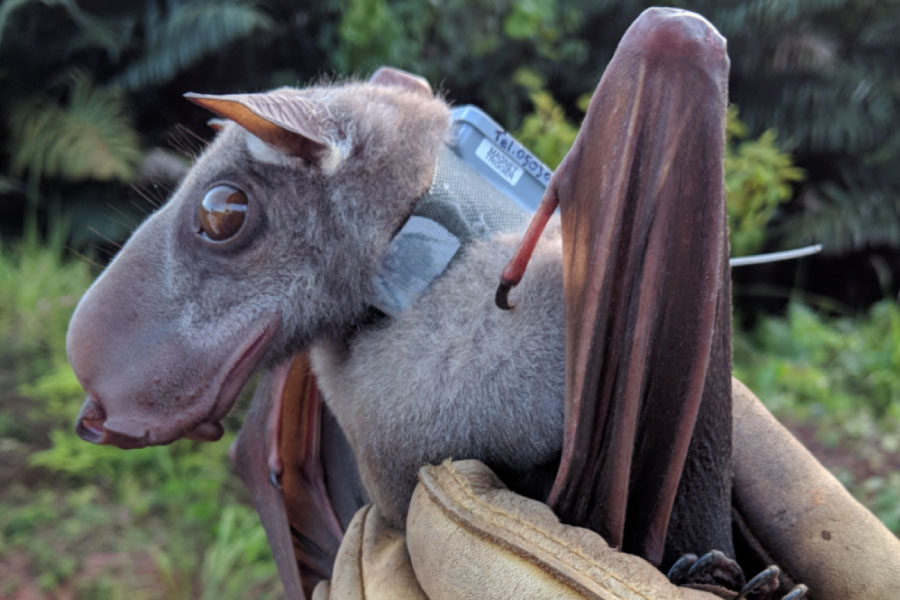

- Scientific Name: Hypsignathus monstrosus
- Class: Mammalia
- Order: Chiroptera
- Family: Pteropodidae
- Where Found: Western and Central Africa
- Conservation Status: Least Concern
The hammer-headed bat, also known as the big-lipped bat, is a large fruit bat found in the rainforests and swamps of Central and West Africa.
Male hammer-headed bats are notable for their distinctive, hammer-shaped heads and enlarged lips, which they use to produce loud, honking calls during mating displays to attract females.
Primarily frugivorous, hammer-headed bats feed on a variety of fruits, especially figs, and play an essential role in seed dispersal within their forest habitats.
You can find out more about bats on this page: Bats – The Ultimate Guide
Straw-Colored Fruit Bat


- Scientific Name: Eidolon helvum
- Class: Mammalia
- Order: Chiroptera
- Family: Pteropodidae
- Where Found: Sub-Saharan Africa
- Conservation Status: Near Threatened
The straw-colored fruit bat is a large and migratory bat found throughout sub-Saharan Africa, known for its pale, straw-colored fur and wide wingspan.
These bats are highly social, forming massive colonies that can number in the millions, often roosting in trees in urban and rural areas. As frugivores, they primarily feed on fruits such as mangoes and figs, playing a vital ecological role in pollination and seed dispersal across their extensive migratory routes.
You can find out more about bats on this page: Bats – The Ultimate Guide
Bat-Eared Fox
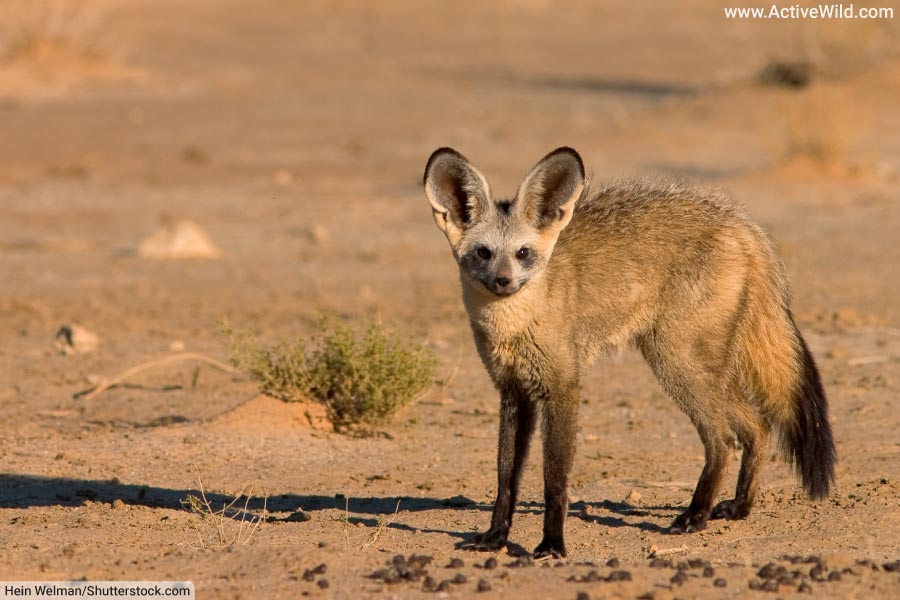

- Scientific Name: Otocyon megalotis
- Class: Mammalia
- Order: Carnivora
- Family: Canidae
- Where Found: Eastern and Southern Africa
- Conservation Status: Least Concern
The bat-eared fox is a small, nocturnal canid (member of the dog family, Canidae) native to the open savannas and arid regions of Eastern and Southern Africa. It is easily recognizable by its large ears, which are used for thermoregulation and detecting insects, particularly termites, which make up a significant portion of its diet.
Social and often seen in pairs or small family groups, bat-eared foxes contribute to their ecosystem by controlling insect populations and dispersing seeds through their varied diet.
You can see every type of fox on this page: Types Of Foxes
Bateleur Eagle


- Scientific Name: Terathopius ecaudatus
- Class: Aves
- Order: Accipitriformes
- Family: Accipitridae
- Where Found: Sub-Saharan Africa
- Conservation Status: Endangered
The bateleur, or bateleur eagle is a striking bird of prey found in the open savannas and woodlands of sub-Saharan Africa.
Recognizable by its bold black, white, and chestnut plumage, as well as its distinctive red face and legs, this African eagle is renowned for its acrobatic flight displays.
As a scavenger and predator, the bateleur eagle feeds on a diverse diet of carrion, birds, and small mammals, playing a crucial role in maintaining the health and balance of its ecosystem.
You can find out more about birds on this page: Birds – The Ultimate Guide
Black Mamba


- Scientific Name: Dendroaspis polylepis
- Class: Reptilia
- Order: Squamata
- Family: Elapidae
- Where Found: Sub-Saharan Africa
- Conservation Status: Least Concern
The Black Mamba, native to parts of sub-Saharan Africa, is one of the world’s most feared and fastest snakes, capable of moving at speeds up to 12 mph (20 km/h).
Despite its name, the Black Mamba is usually brown to gray in color, with the “black” referring to the inky color inside its mouth, which it displays when threatened. Its venom is highly toxic, but this safari reptile is generally elusive and will avoid human interaction if possible.
You can find out more about this animal on this page: Black Mamba Facts
Boomslang


- Scientific Name: Dispholidus typus
- Class: Reptilia
- Order: Squamata
- Family: Colubridae
- Where Found: Sub-Saharan Africa
- Conservation Status: Least Concern
The Boomslang is a highly venomous snake native to sub-Saharan Africa. It has distinctive green and brown coloration and, being arboreal (tree-dwelling), is an excellent climber.
This African reptile feeds on birds, eggs, and small mammals. Despite its potent venom, the Boomslang is generally shy and avoids human contact, resulting in few reported bites.
Discover different types of snakes on this page: Types of Snakes
Bushbaby – Mohol Bushbaby
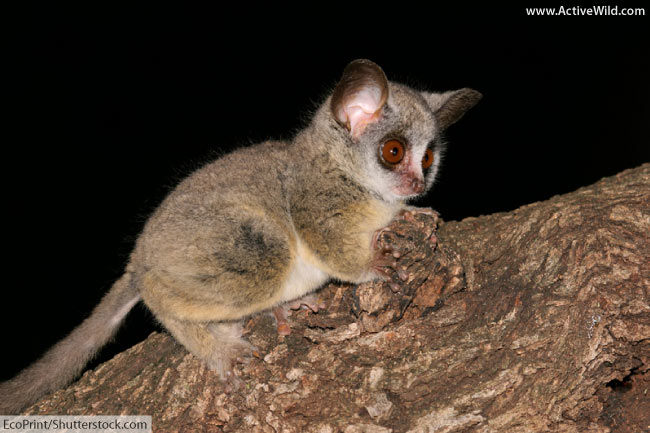

- Scientific Name: Galago moholi
- Class: Mammalia
- Order: Primates
- Family: Galagidae
- Where Found: Southern Africa
- Conservation Status: Least Concern
The Mohol bushbaby, also known as the southern lesser galago, is a small nocturnal primate found in the woodlands and savannas of Southern Africa. It has large, round eyes adapted for night vision, and strong hind legs that allow it to leap great distances between trees.
These agile creatures primarily feed on insects, tree gum, and fruits, and are known for their distinctive vocalizations, which help them communicate and navigate in the dark.
The Mohol bushbaby is one of nineteen species of bushbabies (or galagos) currently recognized by the Catalogue of Life, an online database of species. (Source)
You can see more nocturnal animals on this page: Nocturnal Animals List with Pictures & Facts
Caracal


- Scientific Name: Caracal caracal
- Class: Mammalia
- Order: Carnivora
- Family: Felidae
- Where Found: Africa, Middle East, Central Asia, and India
- Conservation Status: Least Concern
The caracal is a sleek and powerful medium-sized wild cat found in Africa, the Middle East, and parts of Central Asia.
Known for its distinctive tufted ears and reddish-gold coat, the caracal is an adept hunter, capable of leaping high into the air to catch birds in flight.
Solitary and primarily nocturnal, caracals hunt a variety of prey, including small mammals, birds, and reptiles, and are highly adaptable to different environments, from savannas to forests.
You can find out more about this animal on this page: Caracal Facts
Cheetah


- Scientific Name: Acinonyx jubatus
- Class: Mammalia
- Order: Carnivora
- Family: Felidae
- Where Found: Sub-Saharan Africa, Iran
- Conservation Status: Vulnerable
The cheetah is the world’s fastest land animal, capable of reaching speeds up to 70 miles per hour in short bursts. One of the most eagerly-searched for safari animals, it is primarily found in the grasslands and savannas of Africa.
This distinctive cat is easily recognized by its slender body, deep chest, distinctive black “tear marks” running from the eyes to the mouth, and spotted coat.
Cheetahs rely on their exceptional speed and agility to hunt, often chasing down antelope and other fast-moving prey during the day.
You can find out more about this animal on this page: Cheetah Facts
Crocodile – Nile Crocodile


- Scientific Name: Crocodylus niloticus
- Class: Reptilia
- Order: Crocodylia
- Family: Crocodylidae
- Where Found: Sub-Saharan Africa, Nile Basin, Madagascar
- Conservation Status: Least Concern
The Nile crocodile is a formidable safari predator found in rivers, marshes, and lakes throughout sub-Saharan Africa. It is the largest reptile found in Africa, and the second-largest in the world, after the saltwater crocodile of Asia and Australia, and is one of several crocodile species found in Africa.
Known for its powerful jaws and stealthy hunting techniques, the Nile crocodile can take down large prey, including zebras, wildebeests, and even humans. This crocodile is an essential part of its ecosystem, playing a critical role in maintaining the balance of its aquatic habitats.
You can find out more about this animal on this page: Nile Crocodile Facts
You can see all of the crocodiles in Africa on this page: Crocodiles In Africa
Giraffe
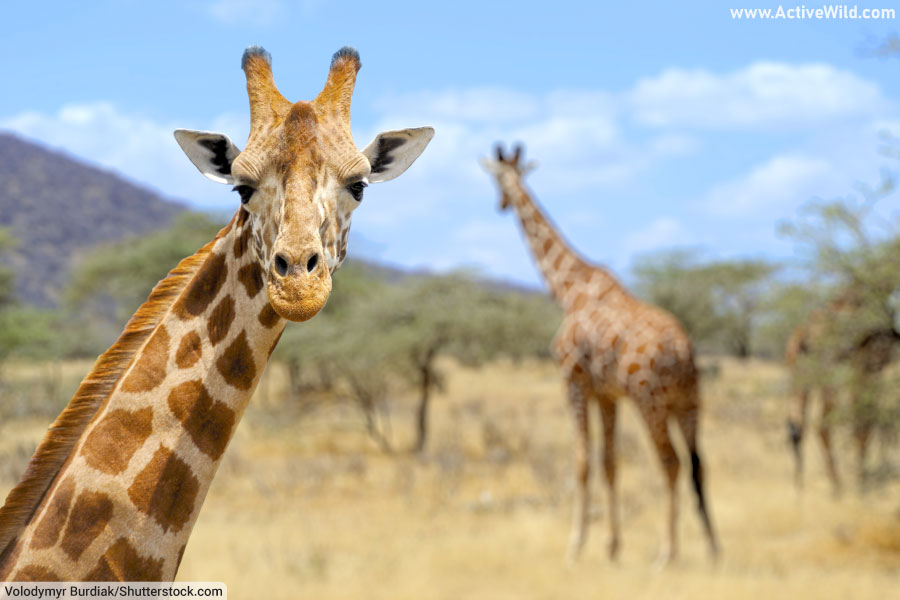

- Scientific Name: Giraffa camelopardalis
- Class: Mammalia
- Order: Artiodactyla
- Family: Giraffidae
- Where Found: Sub-Saharan Africa
- Conservation Status: Vulnerable
The giraffe is the world’s tallest land animal, native to the savannas and open woodlands of Africa, easily identifiable by its long neck, distinctive coat patterns, and towering legs.
These gentle giants use their great height to browse on leaves and buds high up in acacia trees, which other herbivores cannot reach. Their unique cardiovascular adaptations allow giraffes to manage blood flow effectively despite their great height.
The only other animal in the giraffe family is the endangered okapi, an animal you’re unlikely to see on safari due to its rarity and secretive nature.
You can find out more about this animal on this page: Giraffe Facts
Gorilla
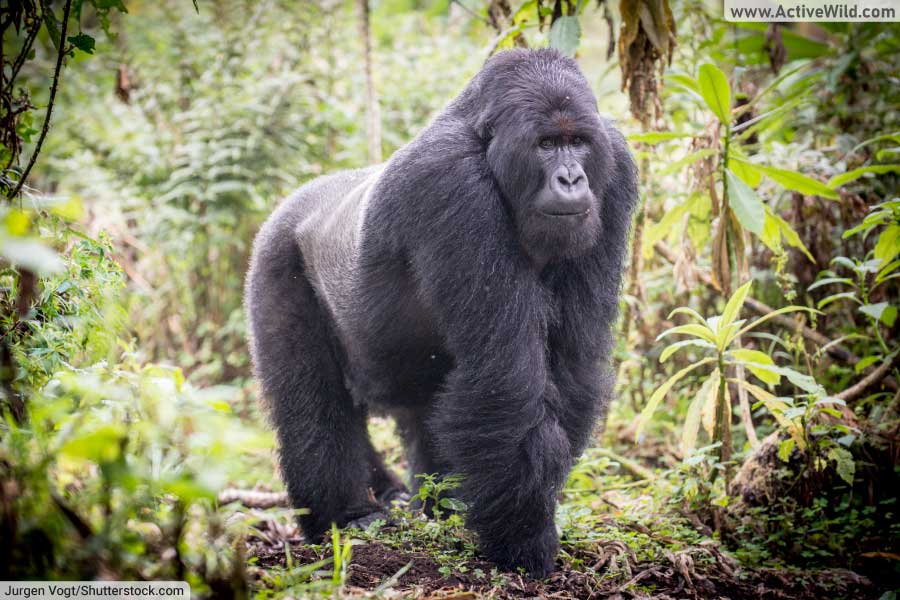

- Scientific Name: Gorilla gorilla (Western Gorilla), Gorilla beringei (Eastern Gorilla)
- Class: Mammalia
- Order: Primates
- Family: Hominidae
- Where Found: Central Africa
- Conservation Status: Both Species Critically Endangered
Gorillas are the largest living primates, native to the dense forests of Central Africa, known for their impressive size, strength, and social structures.
Living in groups called troops, led by a dominant silverback male, gorillas exhibit complex behaviors and strong family bonds. They are primarily herbivorous, feeding on leaves, stems, and fruit, and play a vital role in their ecosystem by aiding in seed dispersal and maintaining forest health.
There are two species of gorilla: the western gorilla and eastern gorilla, both of which are currently critically endangered.
You can find out more about this animal on this page: Western Gorilla Facts
Hippopotamus
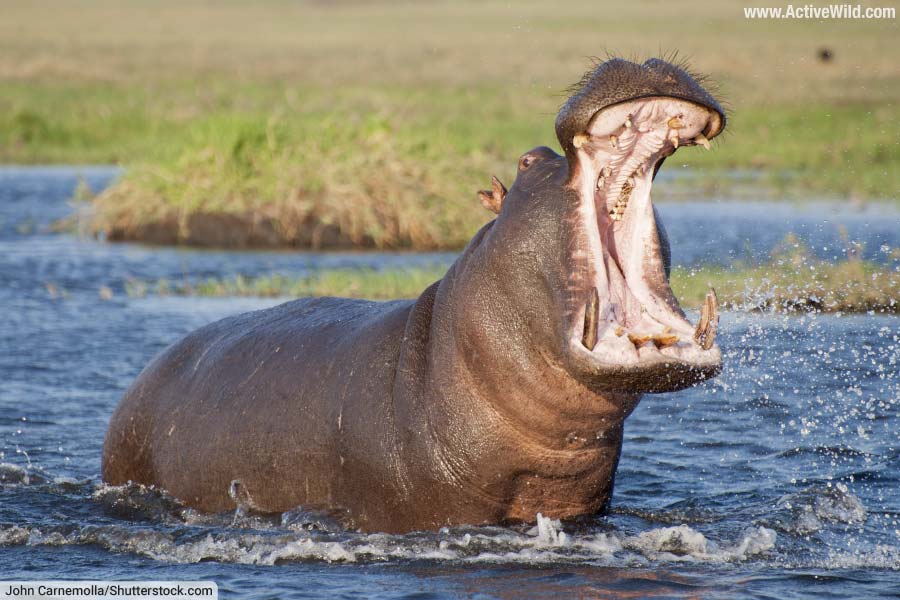

- Scientific Name: Hippopotamus amphibius
- Class: Mammalia
- Order: Artiodactyla
- Family: Hippopotamidae
- Where Found: Sub-Saharan Africa
- Conservation Status: Vulnerable
The hippopotamus is a large, mostly herbivorous mammal found in sub-Saharan Africa, known for its massive size, barrel-shaped body, and large mouth with formidable tusks.
Despite its seemingly docile appearance, the hippo is highly territorial and can be extremely aggressive, particularly in water where it spends much of its to keep cool.
Hippos play a crucial role in their ecosystem by creating channels and pools in waterways, which benefits other aquatic species, and their dung provides essential nutrients for aquatic plants and fish.
You can find out more about this animal on this page: Hippopotamus Facts
Honey Badger
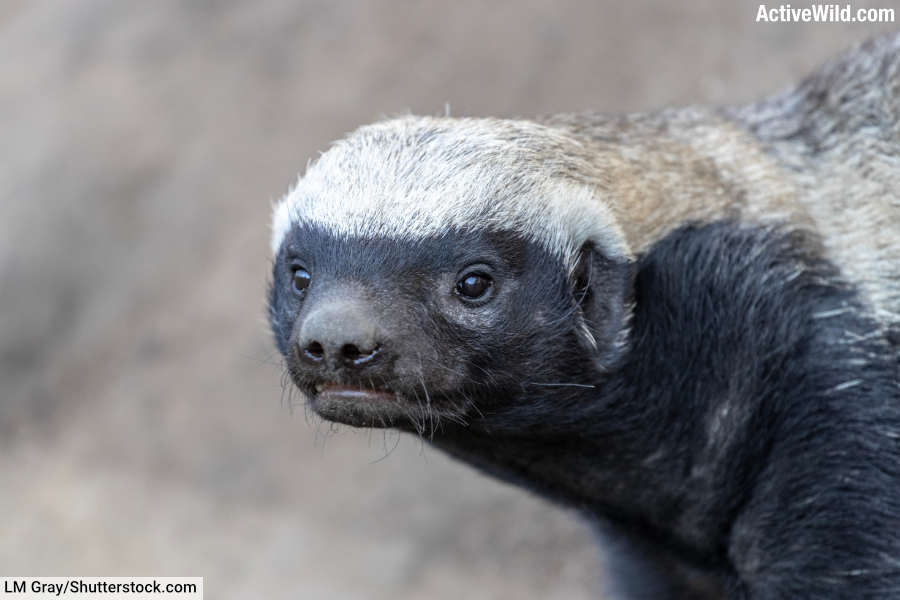

- Scientific Name: Mellivora capensis
- Class: Mammalia
- Order: Carnivora
- Family: Mustelidae
- Where Found: Africa, Middle East, and India
- Conservation Status: Least Concern
The honey badger, also known as the ratel, is a small but fierce mammal found in Africa, the Middle East, and the Indian subcontinent, renowned for its toughness and fearless nature. It has a stocky build, a thick skin that provides protection from predators and bee stings, and a distinctive white stripe running from its head to the base of its tail.
Honey badgers are omnivorous, with a diet that includes honey, insects, small mammals, and even venomous snakes.
You can find out more about this animal on this page: Honey Badger Facts
Hyena – Brown


- Scientific Name: Parahyaena brunnea
- Class: Mammalia
- Order: Carnivora
- Family: Hyaenidae
- Where Found: Southern Africa
- Conservation Status: Near Threatened
The brown hyena, also known as the strandwolf, is a scavenger found in the arid regions of Southern Africa, including the Kalahari Desert and coastal areas. It has a shaggy brown coat, pointed ears, and strong jaws, which are well-adapted for crushing bones.
Living in small social groups called clans, brown hyenas primarily feed on carrion, supplemented by fruits, insects, and small animals, and they play a crucial role in their ecosystem by cleaning up carcasses and preventing the spread of disease.
Hyena – Spotted
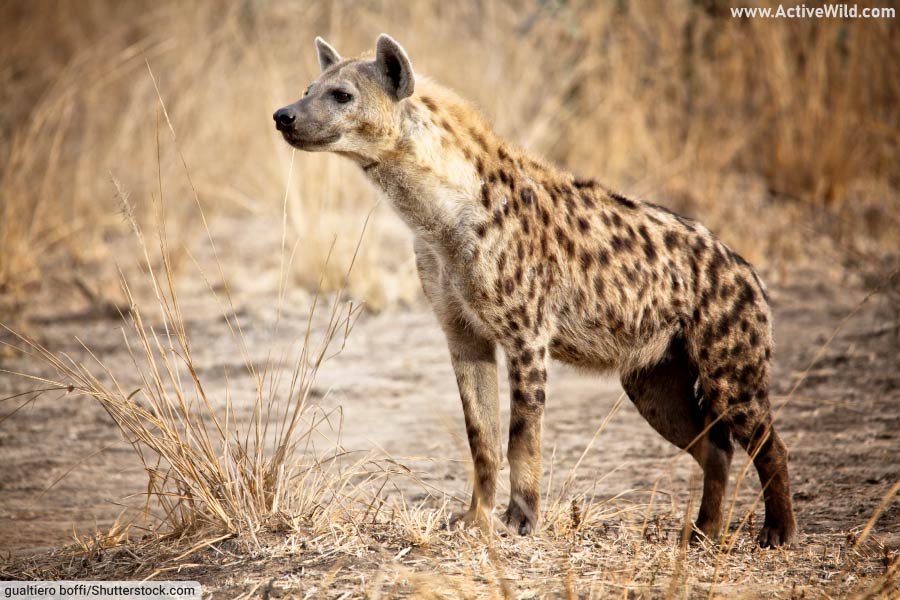

- Scientific Name: Crocuta crocuta
- Class: Mammalia
- Order: Carnivora
- Family: Hyaenidae
- Where Found: Sub-Saharan Africa
- Conservation Status: Least Concern
The spotted hyena, also known as the laughing hyena, is a highly adaptable predator found across sub-Saharan Africa.
Recognizable by its sandy coat with dark spots, powerful build, and distinctive whooping calls, the spotted hyena lives in complex social groups called clans.
Spotted hyenas have incredibly strong jaws capable of crushing bones, and their diverse diet includes carrion, hunted prey, and even fruits. Despite being known as scavengers, spotted hyenas hunt the majority of their prey.
You can find out more about this animal on this page: Spotted Hyena Facts
Jackal – Black-Backed
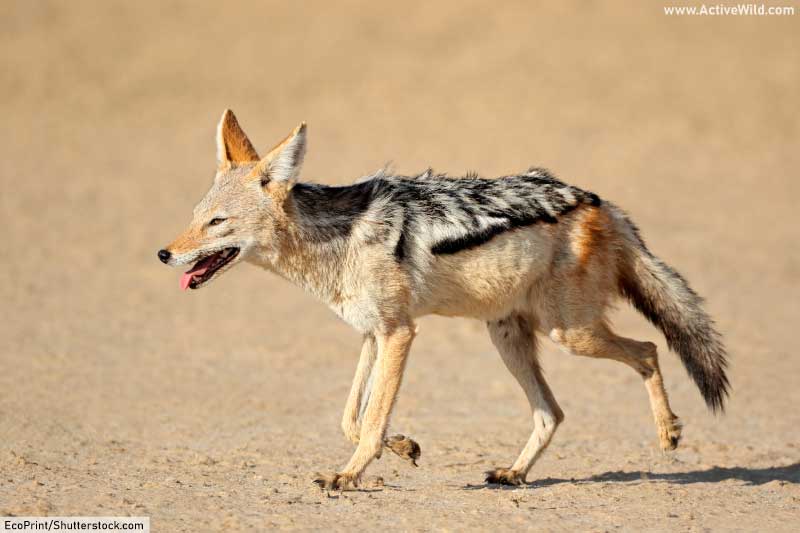

- Scientific Name: Canis mesomelas
- Class: Mammalia
- Order: Carnivora
- Family: Canidae
- Where Found: Eastern and Southern Africa
- Conservation Status: Least Concern
The black-backed jackal is a medium-sized canid (member of the dog family, Canidae) found in Eastern and Southern Africa, recognized by its reddish-brown coat and distinctive black saddle marking on its back.
An opportunistic omnivore, the black-backed jackal has a varied diet that includes small mammals, birds, insects, fruits, and scavenged carcasses.
The species is known for its monogamous pair bonds and complex social structures, often working in pairs or small family groups to hunt and protect its territory.
You can find out more about this animal on this page: Black-Backed Jackal Facts
Jackal – Side-Striped
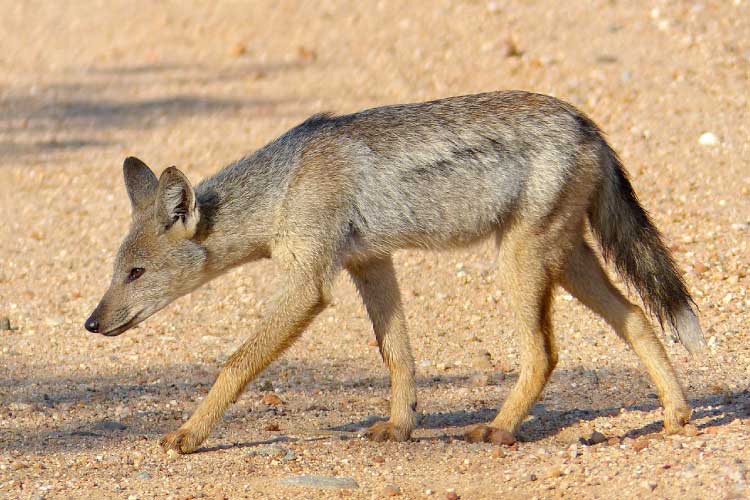

- Scientific Name: Canis adustus
- Class: Mammalia
- Order: Carnivora
- Family: Canidae
- Where Found: Sub-Saharan Africa
- Conservation Status: Least Concern
The side-striped jackal is a medium-sized canid (member of the dog family, Canidae) native to Central and Southern Africa. It is identifiable by its grayish-brown coat, white-tipped tail, and distinctive light stripes running along its sides.
Unlike other jackal species, the side-striped jackal prefers closed habitats, such as woodlands and savannas near water sources. These omnivorous animals have a varied diet that includes fruits, small mammals, birds, and insects, and they are known for their adaptability and solitary or paired lifestyle.
You can see EVERY species of dog on this page: Wild Dog Species List with Pictures and Facts
Leopard


- Scientific Name: Panthera pardus
- Class: Mammalia
- Order: Carnivora
- Family: Felidae
- Where Found: Sub-Saharan Africa, Northeast Africa, Central Asia, India, China
- Conservation Status: Vulnerable
One of the “Big Five” safari animals, the leopard is a large and adaptable wild cat found in a variety of habitats across sub-Saharan Africa, parts of Asia, and the Indian subcontinent.
Known for its stunning spotted coat, leopards are solitary and elusive predators, skilled at climbing trees and capable of taking down prey much larger than themselves.
The leopard’s diet is highly varied, including ungulates, primates, and birds. It often drags its food into trees to protect it from other large predators.
You can find out more about this animal on this page: Leopard Facts
Lion
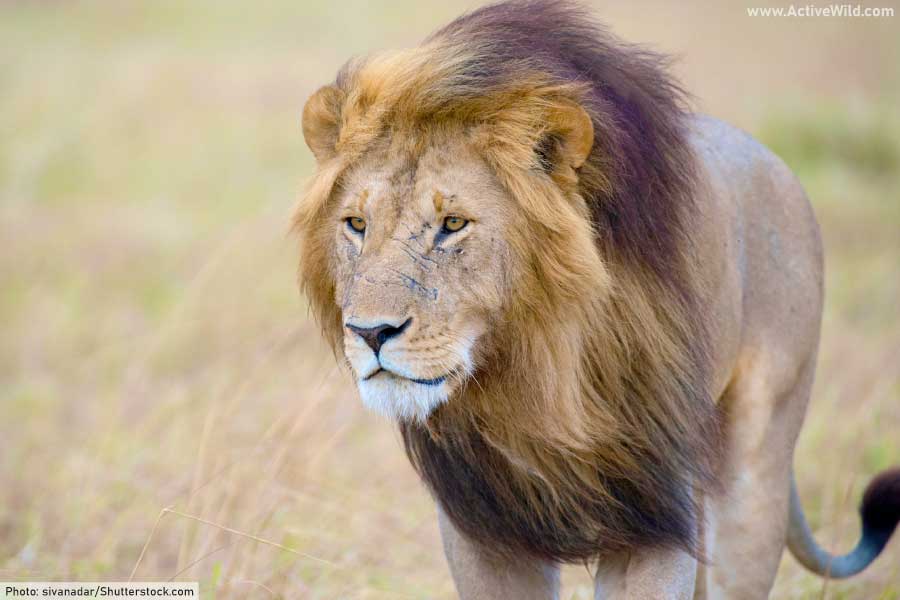

- Scientific Name: Panthera leo
- Class: Mammalia
- Order: Carnivora
- Family: Felidae
- Where Found: Sub-Saharan Africa, India (Gir Forest)
- Conservation Status: Vulnerable
The lion is perhaps the most iconic of all safari animals. The second-largest member of the cat family (after the tiger), the lion is found primarily in the savannas and grasslands of sub-Saharan Africa. (A small population is also found in the Gir Forest of India.)
Known for the majestic mane of the male, the lion lives in social groups called prides, which typically consist of related females, their offspring, and a few dominant males.
Lions are apex predators with a diet that includes large ungulates such as zebras and wildebeests, and they are renowned for their cooperative hunting strategies and impressive roars that can be heard up to five miles (8 kilometers) away.
You can find out more about this animal on this page: Lion Facts
Marabou Stork
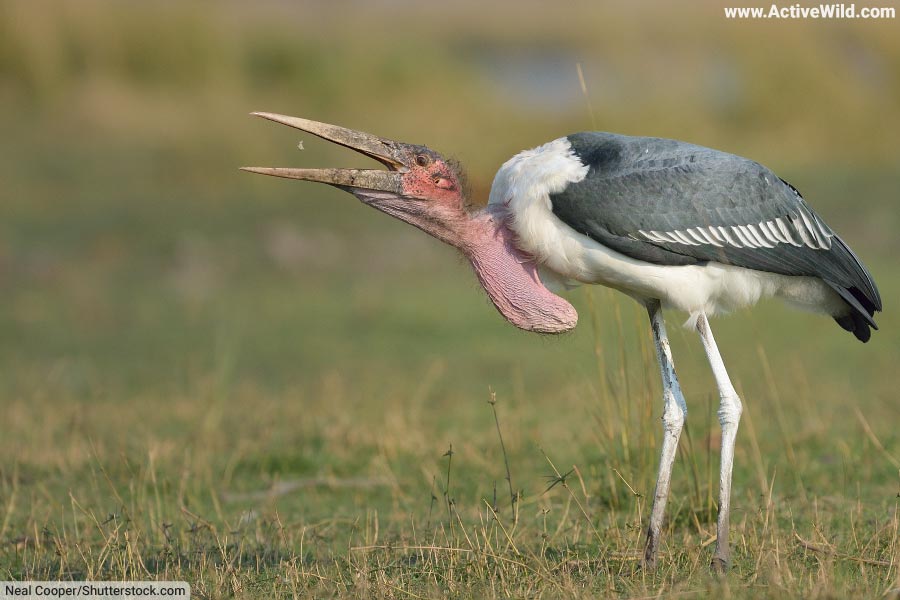

- Scientific Name: Leptoptilos crumenifer
- Class: Aves
- Order: Ciconiiformes
- Family: Ciconiidae
- Where Found: Sub-Saharan Africa
- Conservation Status: Least Concern
The marabou stork is a large wading bird found throughout sub-Saharan Africa, recognizable by its bald head, massive bill, and distinctive throat pouch.
Often referred to as the “undertaker bird” due to its dark plumage and hunched posture, the marabou stork is a scavenger that feeds on carrion, garbage, and occasionally small animals, playing a crucial role in cleaning up its environment.
Despite their ungainly appearance, marabou storks are powerful flyers, often seen soaring at great heights on thermals.
You can see more weird-looking animals on this page: Weird Animals List with Pictures
Martial Eagle
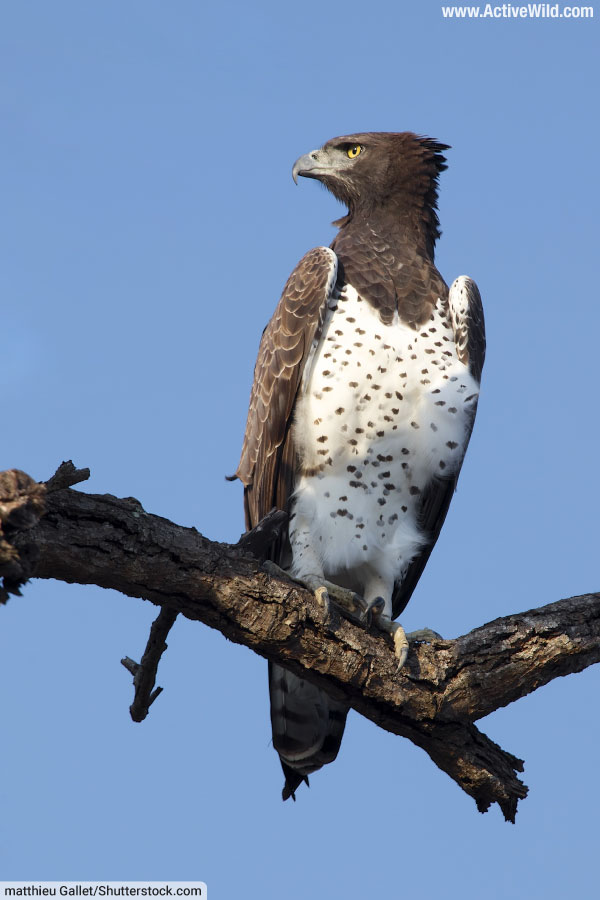

- Scientific Name: Polemaetus bellicosus
- Class: Aves
- Order: Accipitriformes
- Family: Accipitridae
- Where Found: Sub-Saharan Africa
- Conservation Status: Endangered
The martial eagle is one of Africa’s largest and most powerful eagles, found in open and semi-open habitats such as savannas and wooded regions across sub-Saharan Africa.
With a wingspan that can exceed 2.5 meters and a striking appearance characterized by dark brown upperparts and white underparts with black spots, it is a formidable predator.
The martial eagle is an apex predator (a predator with no predators of its own). It hunts medium-sized mammals, birds, and reptiles.
You can see more apex predators on this page: Apex Predators List
Mongoose – Banded


- Scientific Name: Mungos mungo
- Class: Mammalia
- Order: Carnivora
- Family: Herpestidae
- Where Found: Sub-Saharan Africa
- Conservation Status: Least Concern
The banded mongoose is a small, social mammal native to the savannas, woodlands, and grasslands of sub-Saharan Africa, recognized by its distinctive dark horizontal stripes across its grayish-brown body.
These highly social animals live in large, cooperative groups that work together to forage, care for their young, and defend against predators.
Banded mongooses have a varied diet that includes insects, small vertebrates, eggs, and fruit, and they are known for their remarkable ability to coordinate group activities, including mobbing behaviors to ward off larger predators.
Ostrich
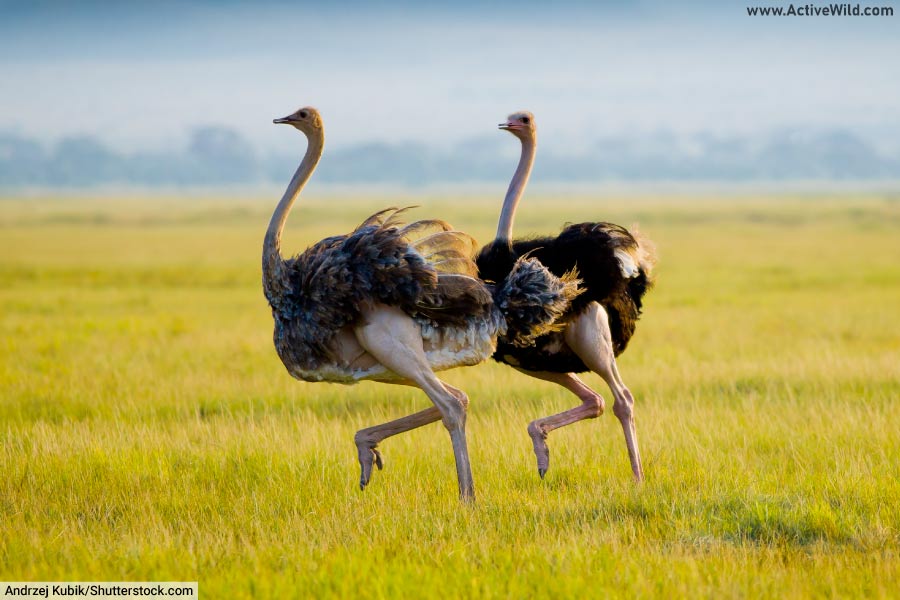

- Scientific Name: Struthio camelus
- Class: Aves
- Order: Struthioniformes
- Family: Struthionidae
- Where Found: Africa
- Conservation Status: Least Concern
The ostrich is the world’s largest and fastest-running bird, native to the savannas and deserts of Africa. It is flightless, with long, powerful legs that enable it to run at speeds of up to 45 miles per hour, and large eyes (the largest of any land animal) adapted for spotting predators from a distance.
Ostriches are omnivorous, feeding on a variety of plants, seeds, and small animals, and their social structure includes both solitary males and communal nesting with females sharing incubation duties.
You can find out more about this animal on this page: Ostrich Facts
Pangolin – Ground
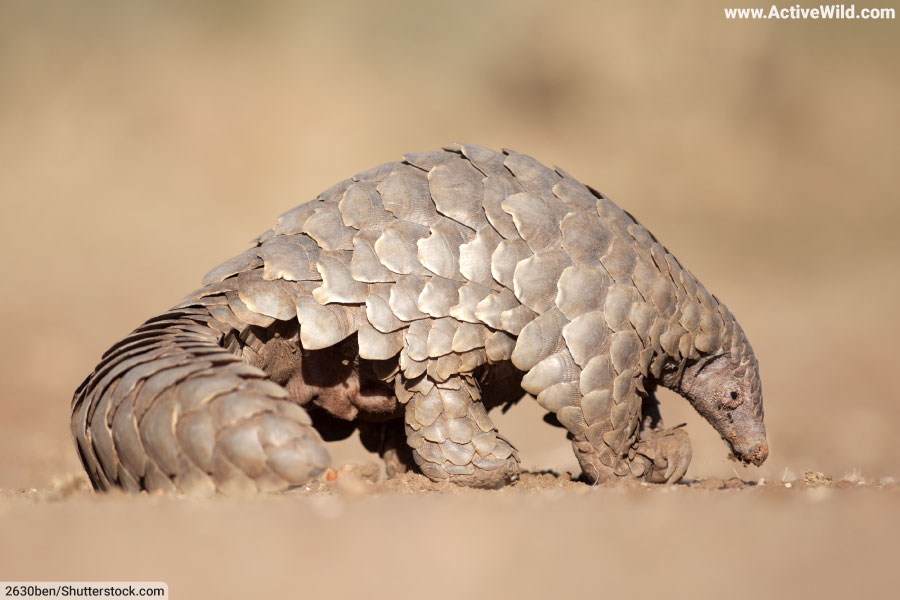

- Scientific Name: Smutsia temminckii
- Class: Mammalia
- Order: Pholidota
- Family: Manidae
- Where Found: Sub-Saharan Africa
- Conservation Status: Vulnerable
The ground pangolin, also known as the Cape pangolin, is a solitary, nocturnal mammal found in the savannas and woodlands of Southern and Eastern Africa. It is covered in large, protective keratin scales, which it rolls into a tight ball to defend against predators.
Ground pangolins mainly feed on ants and termites, using their long, sticky tongues to extract insects from nests.
You can see more weird animals on this page: Weird Animals List with Pictures
Porcupine (Cape Porcupine)


- Scientific Name: Hystrix africaeaustralis
- Class: Mammalia
- Order: Rodentia
- Family: Hystricidae
- Where Found: Southern Africa
- Conservation Status: Least Concern
The Cape porcupine is the world’s largest porcupine species. It is found in a variety of habitats including forests, grasslands, and rocky outcrops across Southern and Central Africa.
This large rodent has a coat of long, sharp quills, which can be raised to deter predators and are capable of inflicting painful wounds.
A nocturnal herbivore, the Cape porcupine feeds on roots, tubers, and bark, and they play an important role in their ecosystem by aiding in seed dispersal and soil aeration through their digging activities.
You can find out more about rodents on this page: Rodents – The Ultimate Guide
Red-Billed Oxpecker


- Scientific Name: Buphagus erythrorynchus
- Class: Aves
- Order: Passeriformes
- Family: Buphagidae
- Where Found: Sub-Saharan Africa
- Conservation Status: Least Concern
The red-billed oxpecker is a small bird found in sub-Saharan Africa. Both it and the related yellow-billed oxpecker are known for their symbiotic relationship with large herbivores such as buffalo, giraffes, and rhinoceroses. It is often photographed standing atop one of these better-known safari animals.
The red-billed oxpecker is easily identifiable by its brown plumage, bright red bill, and yellow eye-ring. Red-billed oxpeckers feed on ticks, dead skin, and other parasites found on their host animals, providing a cleaning service while also benefiting from a consistent food source.
Discover different types of birds on this page: Types of Birds
Rhino – Black
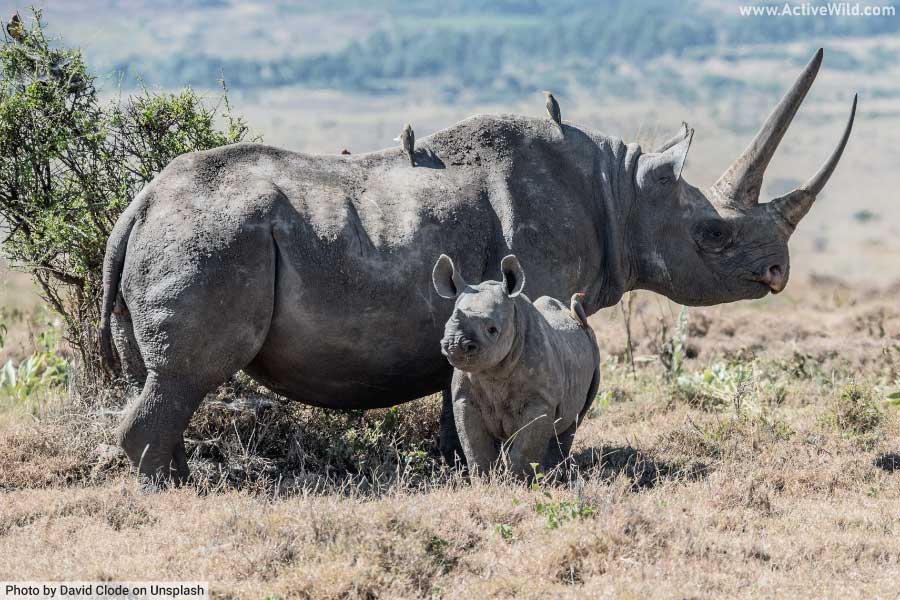

- Scientific Name: Diceros bicornis
- Class: Mammalia
- Order: Perissodactyla
- Family: Rhinocerotidae
- Where Found: Eastern and Southern Africa
- Conservation Status: Critically Endangered
The black rhino, or hook-lipped rhino, is a critically endangered species native to various habitats across Southern and Eastern Africa, including savannas, bushlands, and deserts. It is characterized by its prehensile upper lip, which is adapted for grasping leaves and twigs from bushes and trees, distinguishing it from the grazing white rhino.
Despite its bulky appearance, the black rhino is surprisingly agile and can reach speeds of up to 34 miles per hour, but it faces significant threats from poaching and habitat loss.
Despite their names, both species of rhino found in Africa – the black rhino and white rhino – are gray.
You can find out more about this animal on this page: Black Rhino Facts
Rhino – White
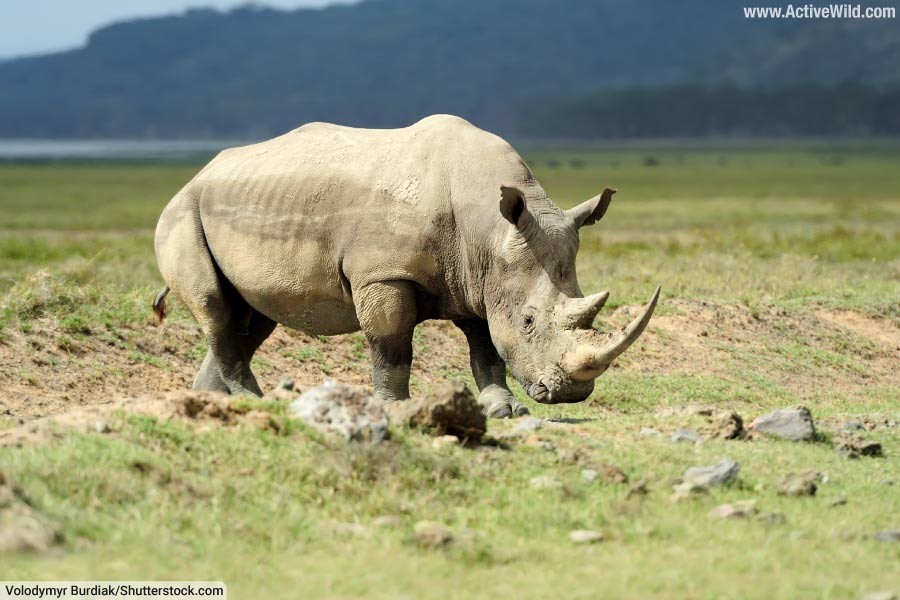

- Scientific Name: Ceratotherium simum
- Class: Mammalia
- Order: Perissodactyla
- Family: Rhinocerotidae
- Where Found: Southern Africa
- Conservation Status: Near Threatened
The white rhino, also known as the square-lipped rhino, is the largest of the five living rhino species. It is found primarily in the grasslands and savannas of Southern Africa.
The species’ wide, flat mouth is adapted for grazing on grasses, and contrasts with the pointed, prehensile lip of the black rhino.
While less aggressive than its black rhino counterpart, the white rhino also faces severe threats from poaching for its horn, but conservation efforts have helped increase its population in certain protected areas.
You can find out more about this animal on this page: White Rhino Facts
Serval
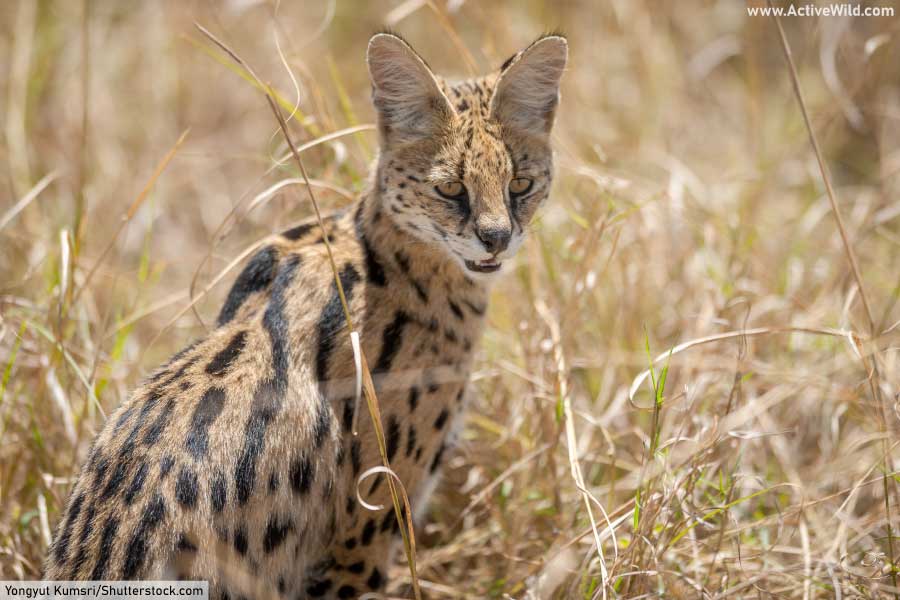

- Scientific Name: Leptailurus serval
- Class: Mammalia
- Order: Carnivora
- Family: Felidae
- Where Found: Sub-Saharan Africa
- Conservation Status: Least Concern
The serval is a medium-sized wild cat native to the grasslands, wetlands, and savannas of sub-Saharan Africa, known for its slender build, long legs, and large, rounded ears. Its golden-yellow coat, marked with black spots and stripes, provides excellent camouflage in tall grasses.
Servals are skilled hunters with remarkable leaping ability, using their keen sense of hearing to locate and pounce on small mammals, birds, and insects, often catching prey with a single, swift jump.
You can find out more about this animal on this page: Serval Facts
Vervet Monkey
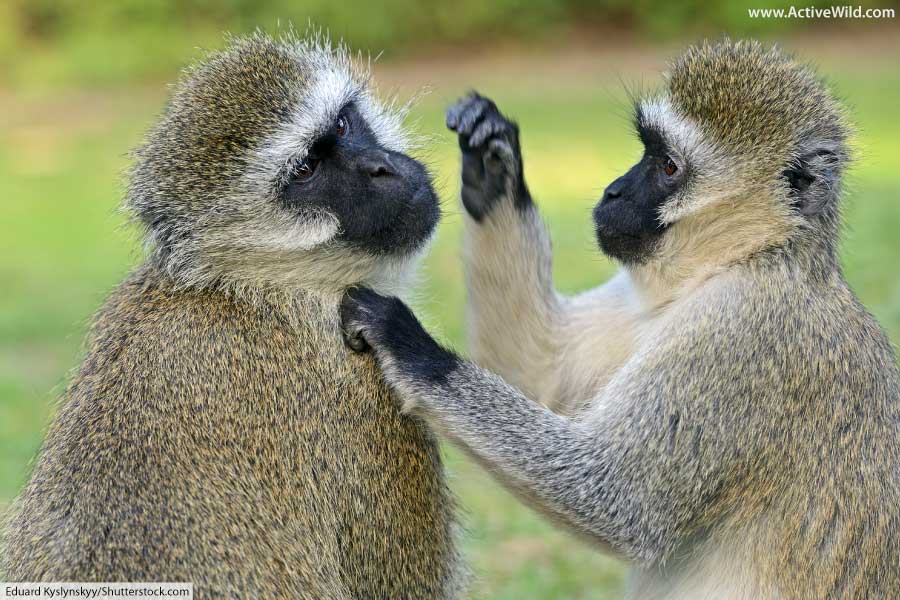

- Scientific Name: Chlorocebus pygerythrus
- Class: Mammalia
- Order: Primates
- Family: Cercopithecidae
- Where Found: Eastern and Southern Africa
- Conservation Status: Least Concern
The vervet monkey is a mid-sized primate found across eastern and southern Africa, often seen in savannas, woodlands, and near human settlements.
Recognizable by its black face and grayish-brown fur, this African monkey is highly social, living in troops that can number up to 70 individuals.
Vervet monkeys have a different alarm call for four major predators: leopard, eagle, python and baboon, allowing the troop to respond appropriately to each threat.
Discover different types of monkeys on this page: Types of Monkeys
Warthog
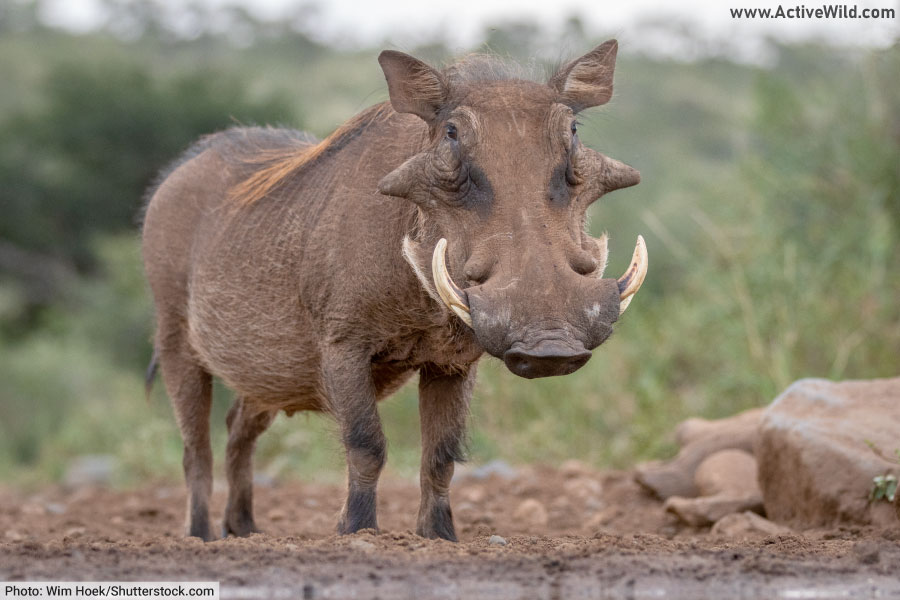

- Scientific Name: Phacochoerus africanus
- Class: Mammalia
- Order: Artiodactyla
- Family: Suidae
- Where Found: Sub-Saharan Africa
- Conservation Status: Least Concern
The vervet monkey is a small to medium-sized primate found throughout Eastern and Southern Africa, known for its distinctive black face, white fringe of fur, and grayish-green coat.
These highly social animals live in troops that can include up to 50 individuals, exhibiting complex social behaviors and vocalizations.
Vervet monkeys are omnivorous, feeding on fruits, leaves, flowers, seeds, and small animals.
You can find out more about this animal on this page: Warthog Facts
You can see more ugly animals on this page: Ugly Animals List with Pictures & Facts
White-Backed Vulture


- Scientific Name: Gyps africanus
- Class: Aves
- Order: Accipitriformes
- Family: Accipitridae
- Where Found: Sub-Saharan Africa
- Conservation Status: Critically Endangered
The white-backed vulture is a large scavenger found across sub-Saharan Africa, commonly seen soaring over savannas and open woodlands in search of carrion. It can be identified by its pale back and underparts, which contrast with its dark brown wings and body. Like other vultures, it has a featherless head, which is an adaptation for hygienic feeding.
You can find out more about birds on this page: Birds – The Ultimate Guide
Yellow-Billed Hornbill (Southern)


- Scientific Name: Tockus leucomelas
- Class: Aves
- Order: Bucerotiformes
- Family: Bucerotidae
- Where Found: Southern Africa
- Conservation Status: Least Concern
The yellow-billed hornbill is a distinctive bird native to the arid and semi-arid regions of Southern Africa, characterized by its long, curved yellow beak and striking black and white plumage.
Often seen foraging on the ground, the omnivorous yellow-billed hornbill feeds on a variety of foods, including insects, small reptiles, seeds, and fruits.
The yellow-billed hornbill has a unique nesting behavior, in which the female and eggs are sealed inside tree cavities, leaving only a small slit for the male to pass food through until the chicks are ready to fledge.
Discover different types of birds on this page: Types of Birds
Yellow-Billed Stork


- Scientific Name: Mycteria ibis
- Class: Aves
- Order: Ciconiiformes
- Family: Ciconiidae
- Where Found: Sub-Saharan Africa
- Conservation Status: Least Concern
The yellow-billed stork is a large wading bird found in wetlands, marshes, and riverbanks across sub-Saharan Africa. The species has a long, yellow bill, red facial skin, and white plumage with black flight feathers.
A skilled hunter, the yellow-billed stork feeds primarily on fish, frogs, and insects, using a technique called “tactile foraging” where it sweeps its open bill through the water to snap shut on any prey it encounters.
Discover different types of birds on this page: Types of Birds
Zebra – Grévy’s


- Scientific Name: Equus grevyi
- Class: Mammalia
- Order: Perissodactyla
- Family: Equidae
- Where Found: Kenya and Ethiopia
- Conservation Status: Endangered
Grévy’s zebra is the largest and most endangered of the three zebra species. It is found in the semi-arid grasslands of Kenya and Ethiopia. Distinguished by its narrow, closely spaced black and white stripes and large, rounded ears, Grévy’s zebra has a more mule-like appearance compared to other zebras.
The species plays a crucial ecological role by grazing on tough grasses and spreading seeds, but it faces significant threats from habitat loss, competition with livestock, and poaching.
You can find out more about zebras on this page: Zebra Facts
Zebra – Plains


- Scientific Name: Equus quagga
- Class: Mammalia
- Order: Perissodactyla
- Family: Equidae
- Where Found: Eastern and Southern Africa
- Conservation Status: Near Threatened
The plains zebra, also known as the common zebra or Burchell’s zebra, is the most widespread zebra species, found in the grasslands and savannas of Eastern and Southern Africa.
This iconic safari animal is easily recognizable by its distinctive black and white stripe pattern, which varies among individuals and is thought to provide camouflage, temperature regulation, and even protection from disease-carrying insects.
Plains zebras are highly social animals, living in large herds that provide protection against predators, and they play a key role in their ecosystem by grazing on grasses and facilitating nutrient cycling.
You can find out more about this animal on this page: Plains Zebra Facts
Discover More With Active Wild
You can see more African animals on this page: African Animals
Visit our main animals page for links to animal information and a complete guide to the animal kingdom: Animals
Discover more African amphibians on this page: African Amphibians
You can see more African reptiles on this page: African Reptiles

